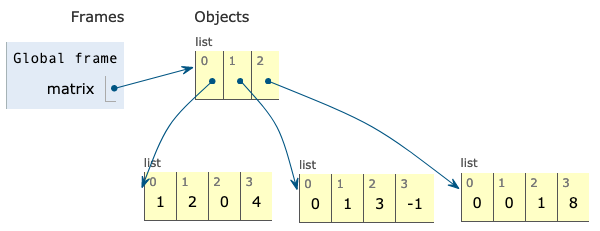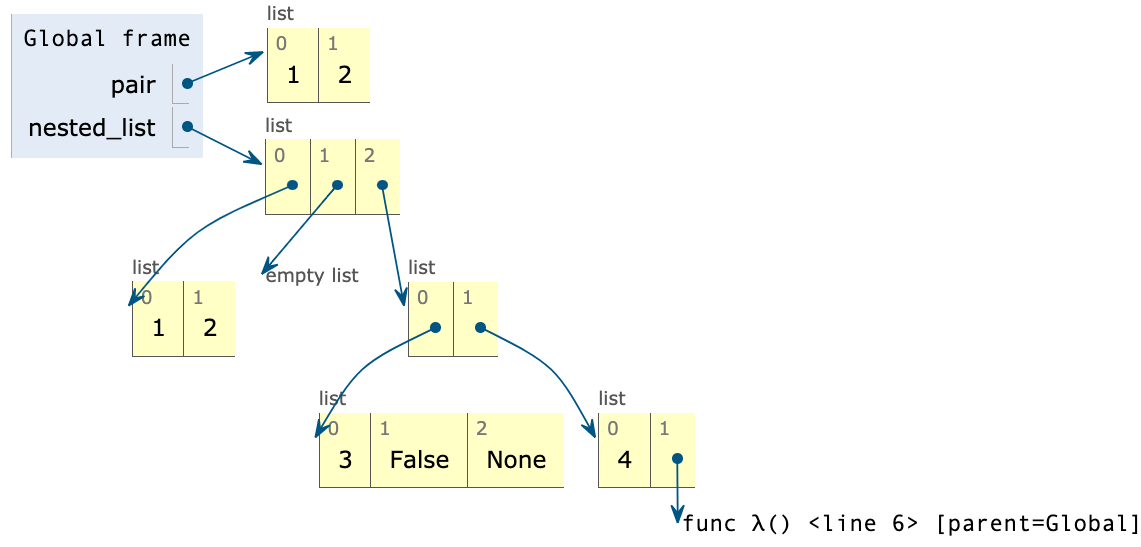Mutability
- Press O or Escape for overview mode.
- Visit this link for a nice printable version
- Press the copy icon on the upper right of code blocks to copy the code
Class outline:
- List diagrams
- Objects & methods
- List mutation & methods
- Tuples
- Mutability
- Beware of mutation
List diagrams
Lists in environment diagrams
Lists are represented as a row of index-labeled adjacent boxes, one per element.
pair = [1, 2]

Nested lists in environment diagrams
Each box either contains a primitive value or points to a compound value.
matrix = [ [1, 2, 0, 4], [0, 1, 3, -1], [0, 0, 1, 8] ]

Nested lists in environment diagrams
A very nested list:
worst_list = [ [1, 2],
[],
[ [3, False, None], [4, lambda: 5]]]

Objects
Objects
An object is a bundle of data and behavior.
A type of object is called a class.
Every value in Python is an object.
- All objects have attributes
- Objects often have associated methods
Strings as objects
name = 'PamelamaDingDong'
What kind of object is it?
type(name)
What data is inside it?
name[0]
name[8:]
What methods can we call?
name.upper()
name.lower()
Lists as objects
names = ['Pamela', 'Spamela', 'Pammyla', 'Ela']
What kind of object is it?
type(names)
What data is inside it?
names[0]
names[-1]
What methods can we call?
names.index("Spamela")
names.copy()
List mutation
Mutating lists with methods
append() adds a single element to a list:
s = [2, 3]
t = [5, 6]
s.append(4)
s.append(t)
t = 0
extend() adds all the elements in one list to a list:
s = [2, 3]
t = [5, 6]
s.extend(4) # 🚫 Error: 4 is not an iterable!
s.extend(t)
t = 0
Mutating lists with methods
pop() removes and returns the last element:
s = [2, 3]
t = [5, 6]
t = s.pop()
remove() removes the first element equal to the argument:
s = [6, 2, 4, 8, 4]
s.remove(4)
Mutating lists with slicing
We can do a lot with just brackets/slice notation:
L = [1, 2, 3, 4, 5]
L[2] = 6
L[1:3] = [9, 8]
L[2:4] = [] # Deleting elements
L[1:1] = [2, 3, 4, 5] # Inserting elements
L[len(L):] = [10, 11] # Appending
L = L + [20, 30]
L[0:0] = range(-3, 0) # Prepending
Dictionary mutation
Dictionary mutation
Starting with an empty dict:
users = {}
Add values:
users["profpamela"] = "b3stp@ssEvErDontHackMe"
Change values:
users["profpamela"] += "itsLongerSoItsMoreSecure!!"
>>> users["profpamela"]
'b3stp@ssEvErDontHackMeitsLongerSoItsMoreSecure!!'
Tuples
Tuples
A tuple is an immutable sequence. It's like a list, but no mutation allowed!
An empty tuple:
empty = ()
# or
empty = tuple()
A tuple with multiple elements:
conditions = ('rain', 'shine')
# or
conditions = 'rain', 'shine'
A tuple with a single element: 🙀
oogly = (61,)
# or
oogly = 61,
Tuple operations
Many of list's read-only operations work on tuples.
Combining tuples into a new tuple:
('come', '☂') + ('or', '☼') # ('come', '☂', 'or', '☼')
Checking containment:
'wally' in ('wall-e', 'wallace', 'waldo') # True
Slicing:
rainbow = ('red', 'orange', 'yellow', 'green', 'blue', 'indigo', 'violet')
roy = rainbow[:3] # ('red', 'orange', 'yellow')
Immutability vs. Mutability
Immutable vs. Mutable
An immutable value is unchanging once created.
Immutable types (that we've covered): int, float, string, tuple
a_tuple = (1, 2)
a_tuple[0] = 3 # 🚫 Error! Tuple items cannot be set.
a_string = "Hi y'all"
a_string[1] = "I" # 🚫 Error! String elements cannot be set.
a_string += ", how you doing?" # 🤔 How does this work?
an_int = 20
an_int += 2 # 🤔 And this?
A mutable value can change in value throughout the course of computation. All names that refer to the same object are affected by a mutation.
Mutable types (that we've covered): list, dict
grades = [90, 70, 85]
grades_copy = grades
grades[1] = 100
words = {"agua": "water"}
words["pavo"] = "turkey"
Name change vs. mutation
The value of an expression can change due to either changes in names or mutations in objects.
Name change:
x = 2
x + x # 4
x = 3
x + x # 6
Object mutation:
x = ['A', 'B']
x + x # ['A', 'B', 'A', 'B']
x.append('C')
x + x # ['A', 'B', 'C', 'A', 'B', 'C']
Mutables inside immutables
An immutable sequence may still change if it contains a mutable value as an element.
t = (1, [2, 3])
t[1][0] = 99
t[1][1] = "Problems"
Equality of contents vs. Identity of objects
list1 = [1,2,3]
list2 = [1,2,3]
Equality: exp0 == exp1
evaluates to True
if both exp0 and exp1 evaluate to objects containing equal values
list1 == list2 # True
Identity: exp0 is exp1
evaluates to True
if both exp0 and exp1 evaluate to the same object
Identical objects always have equal values.
list1 is list2 # False
Beware, Mutation! 👻
Mutation in function calls 🙀
An function can change the value of any object in its scope.
four = [1, 2, 3, 4]
print(four[0])
do_stuff_to(four)
print(four[0])
Even without arguments:
four = [1, 2, 3, 4]
print(four[3])
do_other_stuff()
print(four[3])
Immutability in function calls
Immutable values are protected from mutation.
| Tuple | List |
|---|---|
|
|
Mutable default arguments 🙀
A default argument value is part of a function value, not generated by a call.
def f(s=[]):
s.append(3)
return len(s)
f() # 1
f() # 2
f() # 3
Each time the function is called, s is bound to the same value.
Python Project of The Day!
Anki
Anki: An open-source desktop application for studying flash cards.

Technologies used: Python.
(Github repository)